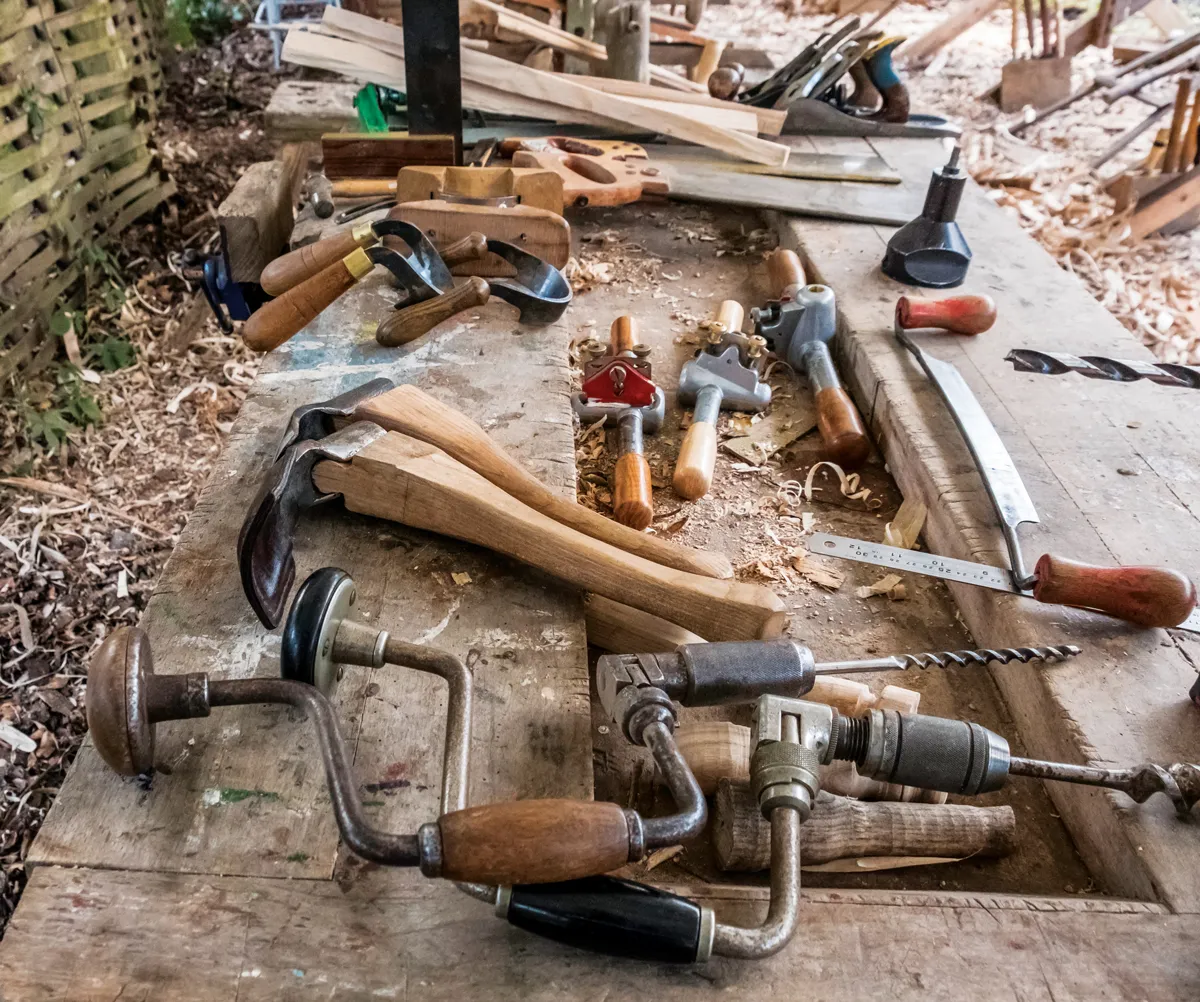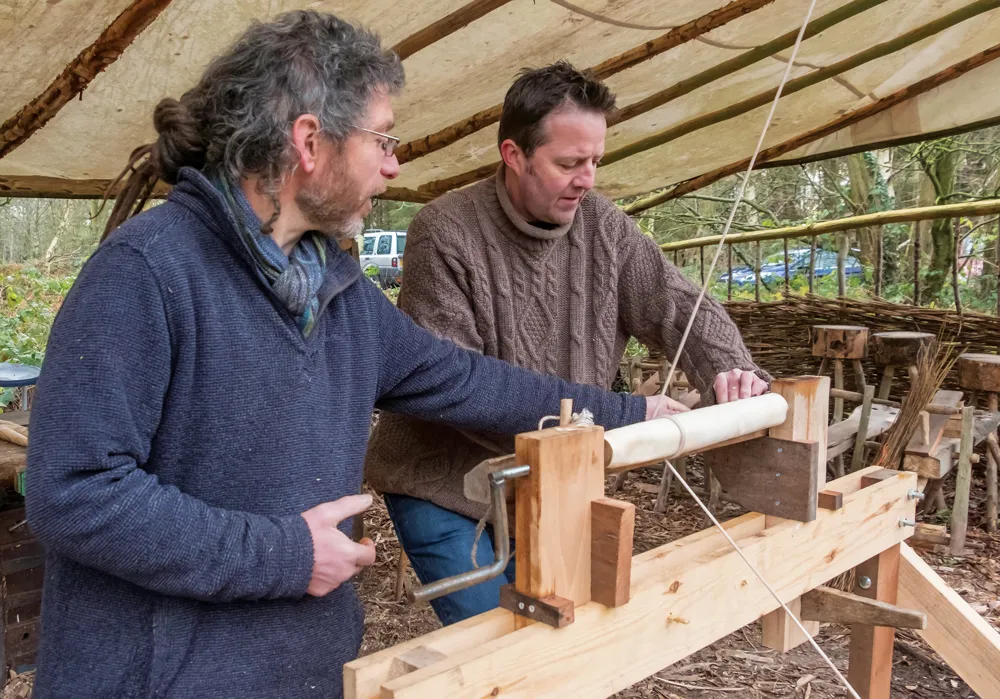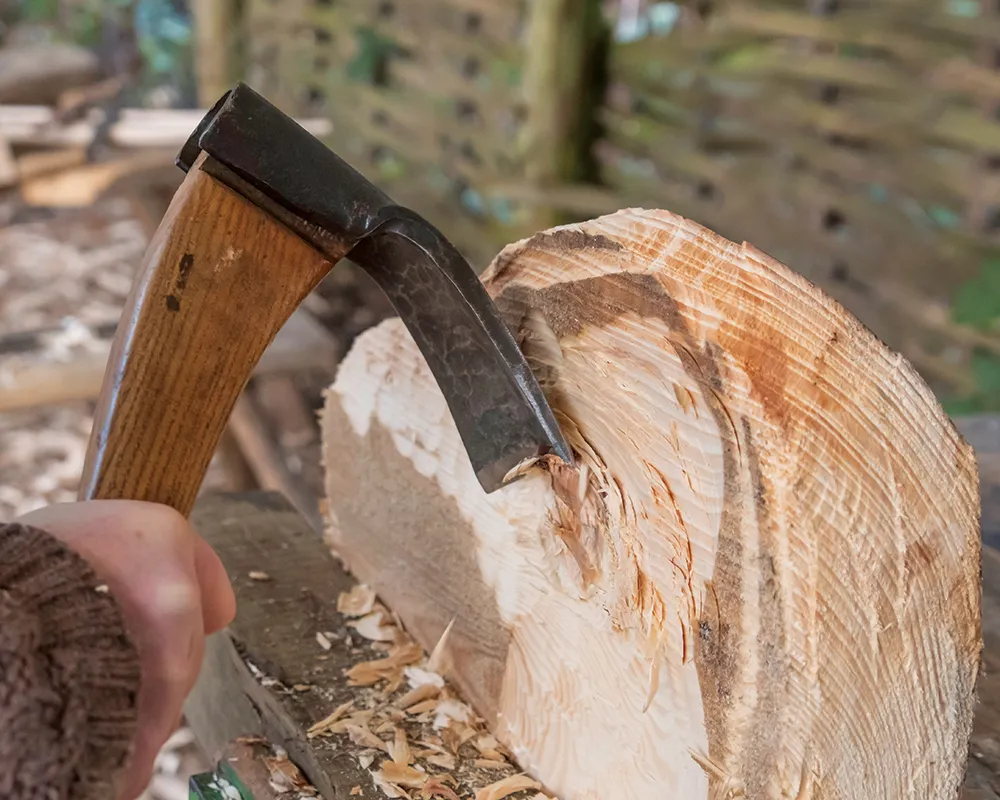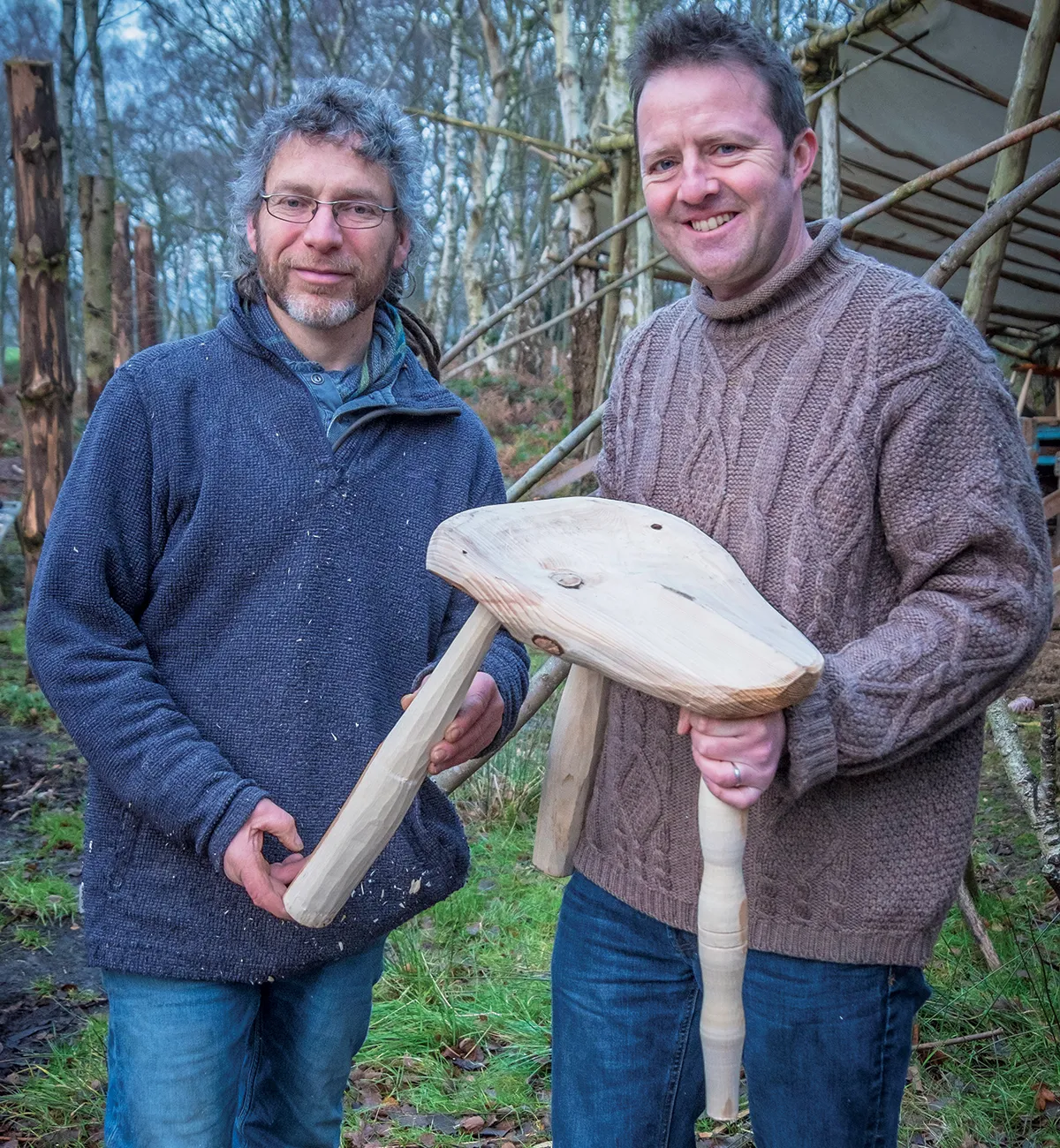Unlike in the BBC Countryfile Magazine office where the day starts with a scramble of emails, phonecalls and meetings, I don’t immediately dive into the hard graft of bodging on a bitter December day deep in the National Forest. Here on the border of Leicestershire and Derbyshire, a blackened kettle steams over a welcome open fire and tea is the civilised order of the day. Of all the lessons I learn over the next six hours, taking my time, breathing slowly and keeping my body relaxed are the most important. In the noise and harsh lighting of the office, these are impossible. Here in the woods, they are essential for safety but also for working smoothly and creating something of worth.
My host, mentor and chief critic for the day is Peter Wood, a nominatively determined sylvan sprite who is impossible to age. I’m quite surprised to find that his tall, 20-something apprentice is his son, Rowan. We chat as the cold rising sun filters through the wintery birches onto the larch-framed, tarpaulin-covered encampment that houses Peter’s pole-lathes, work benches and shave horses.
I discover that Peter has been teaching green woodcraft for over 20 years – and making furniture for even longer. I look around at the neatly built structures, beautifully spindly chairs and keenly honed tools and realise these have been created by Peter himself, which is both impressive and daunting. I’m to make a stool under this craftsman’s gaze and guidance.

Big business of the past
Pole-lathing and hand turning of furniture were a massive business from the pre-industrial era until the first third of the 20th century. Thousands of people were employed making millions of items a year using no more than axes, knives, chisels and foot-powered lathes. The materials they used varied depending on what grew locally – so beech in the Chilterns, and ash and sycamore in the Midlands, for example. Elm was a “weed tree” and so was used everywhere. Not anymore, of course.
As I progress through the day and become a little more adept, my respect for the speed, precision and beauty of their work – embodied now in Peter – only deepens.
I begin with the relatively crude task of splitting a length of ash tree from which the legs of the stool will emerge. This involves aligning the axe blade across the diameter of the log and striking the back of the axe head with a crude wooden mallet. Immediately, I am made aware of the importance of understanding the wood’s grain. A right-angled iron tool – a froe – helps me split the log more accurately.
Grain on the brain
In green woodworking, grain is everything. Carpenters need to understand this flow and swirl, formed by growth surges in the wood, which means I become a little obsessed with it. Among other grainy musings, I start thinking that Peter and Rowan and other bodgers are going against the grain by carving a living outside of the normal office life.
With the ash log split into sufficiently small wedges, I use a hand axe to remove excess wood from each wedge and turn it into a rough cylindrical shape. “A hexagon,” says Peter, whose demonstration of smooth, precise axe strokes makes me rather embarrassed with my hacking. But I get there eventually, if a little more tentatively than I’d have liked.
From here, the aim is to smooth the cylinder further using a draw knife – a bevelled blade with a handle at each end that you pull towards you along the length of the wood to shave it smooth. But you also need something to hold your wood in place – hence the foot clamp/bench structure known as a shave horse.
I love this process. It is rhythmic and deeply satisfying; and impossible to think of anything else while under the spell. Slowly the rough edges soften and wood shavings pile up around me. Peter steps in occasionally to correct my action – he generously says he wants to work a bit of wood to warm himself up but I know that he is performing a little remedial work on my occasionally botched bodge.
As I work we talk and I discover more about the people who come on Peter’s courses. There are retired city financiers getting a belated but vital dose of nature; people hoping to change career or find confidence; couples celebrating an anniversary by learning a new skill together; one man has been coming for 18 years. They all appear to be unified by a desire to use their hands to create something, coupled with a quest for simplicity, peace and something of tangible worth.
The last stage in shaping the legs involves the pole lathe. A foot pump powers a springy branch that pulls a rope that spins your spindle so that you can apply a variety of chisels to it. Again, it is a process of relaxing and not letting the inner monologue dominate what you see, hear and feel. Apply the chisel on the downward press of the foot, withdraw on the upward or you make a complete mess of spirals and grinding noises. When it works, you get a soothing swish of chisel on wood and a flying shaving.

Crude charm
I struggle with this – the manual element of my day job involves steering a mouse and bashing out features and emails on a keyboard – and it is an enormous effort to relax, let the wood tell me where it wanted to go, let my hands follow the rhythm of the lathe.
I get it eventually and am astonished to see a beautifully smooth cylinder with some embellishments appear without the use of any power tools. Alas, I take so long that I have to leave the other two legs unlathed but they retain a crude charm.
With legs made, it’s time for lunch – leek and potato soup warmed over the fire and accompanied by some of Peter’s homemade bread. It is so welcome, warming and delicious after all that activity in the cold, quiet forest.
Post lunch, I make the seat for the stool. Peter has already cut out an unpromising looking chunk of larch with a chainsaw and my first task is to cut out buttock holes – the indentations that make it comfortable to sit on. Peter shows me how to use an adze, dropping its angled blade onto the face of the wood to remove chips. Again, relax, breathe, let the tool do the work.

I find it hard to smite the wood in the same place twice and at first I make little impression. I grimace at my block of wood with some splinters knocked out of it. But perseverance and teeth-grinding concentration (not recommended) begin to pay dividends and the indents appear. We use scorps, travishers and spokeshaves to shape the seat further, smoothing edges and drawing graceful curves from the chainsawed edges. The adze marks begin to disappear and, once Peter has trimmed some of the excess larch with an axe, we have a kidney-shaped (or serpent-head-shaped, as one friend later said) seat.
The last job is to drill holes for the legs, which I do with a hand auger but helped by Peter and Rowan so that I get the correct splay (or angle). And then, finally, a power tool. I use a drill with an extraordinary bit to reduce the diameter of the tops of the legs so they fit into the holes I’ve just bored. With the help of a wooden mallet, I knock the legs into place just as the first twinges of dusk make photography difficult.
It’s finished – I sit on it – it’s solid and comfortable. And I’m overjoyed. In fact, the stress of recent weeks has melted away. I’m sure many of Peter’s students get the same feeling I now have – that they’re doing the wrong job and should be out in the trees, working with wood. Maybe it’s us office dwellers who are going against the grain and people like Peter and Rowan who are following the more natural path – following the wood. Certainly they exude a gentle good-humoured calm that comes from a contented lifestyle.
In the gloaming I count my fingers – well, nine thumbs – and all is well in the world. I pack my stool into the car and head off into the cold night dreaming of alternative careers.

Try it yourself: Green Woodworking Courses around the UK
1. Greenwood Days: Woodland craft courses
Fergus spent the day with Peter Wood. He and friends offer day, weekend, midweek and week-long courses ranging from traditional Windsor chairmaking to contemporary willow sculpture, longbow making to spoon carving.
2. Gudrun Leitz, Hereford
Gudrun teaches the whole range of greenwood crafts; from pole-lathe turned Windsor chairs, ladder back chairs with varied seating, contemporary and free-form sculptural pieces to an ever-expanding range of other projects.
3. Greenwood Guild, London
Based in London with interesting evening classes and weekends rather than day courses. Set up by Barn the Spoon.
4. Woodsmith, Northumberland
Run by Maurice Pyle, these courses concentrate on helping you acquire the hand skills needed to work greenwood using traditional techniques. He aims for an inspiring and relaxing experience in a beautiful and tranquil location.
